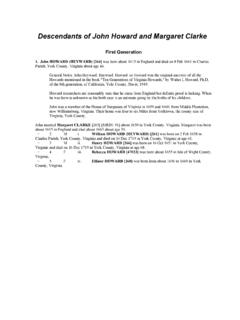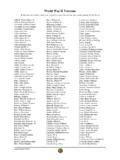Transcription of Modeling Civil War Ironclads - Walter Nelson
1 Modeling Civil WAR IRONCLADSHIPS BySteven Lund andWilliam Hathaway All Rights ReservedCopyright 2007 by Steve Lund and William HathawayProducts described in this publication are protected by one or more Ironclad Press logo is a registered is a registered product and brand names may be trademarks or registered trademarks of their respective owners. Steve LundA serious scale modeler since his teens, his interest in Civil War history inspired the subject matter for this book. He is currently a law enforcement pilot, having served as an Army Aviator in Viet Nam and the reserves. His aerospace background includes Engineering management, Program management, and Marketing. He lives in southern California with his wife, cat, and replica Fieseler Storch. Bill HathawayA practicing Engineer, and a graduate of Texas A&M, he has been an avid ship mod-eler and inventor for over 30 years. He is a former Army Aviator and lives in southern California with his wife, four cats, and two AuthorsCIVIL WAR IRONCLADSTOC-1 ChapterTitleIntroduction1 Modeling The Ironclads2 Scale Data3 Technical Issues4 Contruction Techniques5 Model ConstructionUnion USS Monitor USS Saugus USS Galena USS Passaic USS Choctaw USS Onandaga USS Canonicus USS OsageConfederate CSS Virginia CSS Richmond CSS Arkansas CSS Teaser CSS Tennesee CSS Texas6 Color Schemes7On Servos and Things8 Cannons and Fire Control9 The "Super Monitors"10 ConclusionAppendix: References Introduction-2 Civil WAR IRONCLADSCIVIL WAR IRONCLADSI ntroduction-1 Introduction S.
2 Lund Ship Modeling is a hobby of infinite variety. The subject matter and the different degrees of detail, complexity, and accuracy pursued guarantee models are built from brief historical references and fleshed out by following known styles of maritime architecture and ship building practices of the age. Others are built from meticulously drawn shipyard or builders blueprints and detailed from photos or first hand observation of the actual subject. The degrees of fidelity possible or sought after are a model builder has to first decide is just what level of detail and fidelity he desires to achieve. From that will come the choice of subject matter. For instance, it would not be realistic to hope to achieve the fidelity to scale and historical accuracy possible on a model of a current service naval vessel on a Second Century Greek Trireme. There just isn t the necessary data was the dilemma I faced when I first desired to model the subject matter of this book.
3 The Civil War period was just at the dawning of the era that would produce the plethora of data that would make documenting naval subjects for ship Modeling what it is today. Ships were starting to be built of metal and to plans, rather than by the shipwright s eye. Naval shipyards would soon be regularly and consistently documenting the changes they applied to ships in refit or soon found that the quality, consistency, and the quantity of material available on the subjects was, at best, uneven . I found that there are far more photographs of Union subjects than I had supposed, but that photos of Confederate Ironclads are extremely rare. For instance, there are only two known photos taken by Confederate photographers of their Ironclads , the CSS Chicora and the CSS Jackson. The well known and often published photos of the Tennessee, the Albemarle, and the Atlanta were taken when in Union hands either after their capture or immediately after the end of the war.
4 Plans drawn at the shipyards in the late 1800s are available for one of the Passaic class Monitors (USS Montauk), and parts of blueprint type drawings have been published for the original Monitor and some of the Canonicus class. Lithographs and paintings were produced of the USS Galena, but the only photos known were taken from on board, and don t even begin to show an overall the Confederate subjects, the outlook is bleak. Some attempt was made after the war to make plans from the few existing drawings made by John Porter during the conversion of the hulk of the USS Merrimac to the ironclad CSS Virginia. A few plans of some views by Confederate naval constructors have come to light on some of the other Confederate Ironclads , but no complete plans of any of the vessels are known. The end result is that any current published drawings are conjectural at best. Introduction-2 Civil WAR IRONCLADSThe end result of all this was for me to conclude that I must build my models to a standard that would be termed by aircraft modelers as stand off scale.
5 But, since I enjoy building working models more than I enjoy static models, this doesn t pose much of a hardship. I have always enjoyed the challenge of making a model that is attractive, realistic, and to have it be one that works. If such an approach is not repugnant to the reader, then you can proceed into an activity that coauthor Bill Hathaway and I have found to be immensely interesting and rewarding. We are presenting here, a how we did it book, rather than a how to do it book. You will see that there are challenges in abundance still waiting to be tackled. In short, there is lots of fun to be had here. Civil WAR IRONCLADS1-1 1 Modeling The Ironclads S. LundThe American Civil War spawned a period of unprecedented progress in the technology of naval warfare. When the conflict began the Union Navy was comprised of less than forty wooden hulled ships with only a few of them powered by steam.
6 By the war s end powerful turreted ironclad warships, the high tech wonders of their day, had become the mainstays of the fleet and had profoundly changed the face of naval everyone is familiar with the famous battle between the Ironclads Monitor and Merrimac (actually rechristened the CSS Virginia by the Confederates). What most people are not aware of is that by the end of the war the Union had built over 30 of the Monitor type Ironclads and that the Confederate Navy had likewise constructed over 20 of the casemate type ironclad warship style that they preferred. The USS Monitor was the prototype of the turreted type of ironclad most favored by the union, and she was built in the astonishing time of a little over 100 days. The Union was quite satisfied with the accounting she made of herself at her one and only battle with the CSS Virginia at Hampton Roads in March of 1862. Within days, ships of an improved design were ordered from the Monitor s designer, John Ericsson, and the turreted Monitor type ship became the preferred configuration with the Union Navy for the rest of the war.
7 Monitor was no longer the name of a single ship, it now became a distinct type of ship of which several Classes would emerge. The first significant changes to the basic design were an almost 30 foot increase in length, a refined (rounded) hull design, the pilot house on top of the turret, one 15 inch gun in place of one of the two 11 inch Dahlgren pieces on the original Monitor, increased armor and permanent smokestack and vents. This was the Passaic class, and it would eventually number 10 vessels. Some of them would actually see service in the Spanish-American War and soldier on into the dawn of the twentieth a few months, the requirement for further monitors was identified along with the need for further improvements (based on more combat experience) to the basic single-turret design. The new Canonicus class (sometimes referred erroneously as the Tippecanoe class) had a number of further refinements. The most obvious changes were in the more streamlined hull and raft designs, allowing for an increase in speed without an increase in the horsepower of the engine.
8 In addition, the armament was increased to two 15inch guns, overall length was increased 25 feet, larger boilers were fitted, as well as improvements to the gun recoil system, armor, smokestack (armored and made semi-retractable), and to the ventilation/blower system. 1-2 7200 Civil WAR IRONCLADSIt seems as though the configurations of the Monitor and the Virginia set down the two basic plan forms that both sides would prefer (there would, of course, be exceptions) to build for the rest of the war. If the preferred Union type would be referred to as a tin can on a shingle then the equally descriptive chicken coop on a raft term would have to apply to the Confederate approach. These have been the configurations that have mostly been chosen to model, but you ll see a couple of exceptions here as modeler has three options for the construction method of these ships; Kit building, Kit bashing , and Scratch building. The Monitor and Virginia were the two kit-built ships in our fleet.
9 As with most builders, I modified and enhanced the models as I constructed them. It is certainly easier to change someone else s design than to do it all from scratch. I found this approach to be very useful as I got my feet wet on these type of ships. I freely admit that I learned a lot from the Dumas kits. Kit bashing is a practice almost all modelers engage in to varying degrees. Bill and I might have gone to extremes with him taking the bandsaw to the Monitor and Virginia hulls, and me cutting Cutty Sark hulls down to the waterline to make the Galena and Saugus. I define the term as ending up with a major component from the bashed kit as a significant part of the new building, is just that. The whole thing is designed by or for the modeler from the keel up , and can be whatever size or scale he chooses. This, is by far, the most preferable method when building ships of such a radical departure from what is normally seen in kit form.
10 As a rule, Modeling these craft for radio control calls for some concessions. One has to keep in mind that the fine level of detail found in static models tends to result in a model that is much too fragile to be handled in operational conditions. For example;Whereas one would normally expect to display ship s boats on davits, one should stow them on blocks for a much more robust arrangement. If awnings are erected, they are best made of thin sheet styrene and made removable. If left on the boat while afloat, they tend to want to fly away in the staffs and jack staffs are best made removable by having them plug into tube sockets set in the deck. Rigging lines, stays, and guy wires (for stacks, mostly) should be kept to a minimum due to their fragile nature. Guy wires are best executed in thin brass wire. It remains taut and can be painted or chemically blackened. The on/off switch must be either disguised or concealed under an easily removable hatch, deck section, or WAR IRONCLADS1-3 With the Monitor types, a few technical issues emerge that are common.







